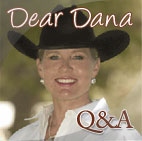Maintaining Softness in the Neck
33rd in a series
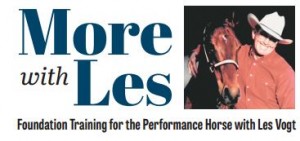 Again, the first place that resistance is going to show up is in your horse’s neck. You’re going to ask him to do something, and rather than softly responding he’s going to stiffen his neck and brace against your hand. You simply have got to train yourself to not let this happen. You have to insist that he be soft in the poll at all times. Why will a horse resist? Because he doesn’t like what you’re doing or he doesn’t like what you want him to do. Where did he get these opinions?
Again, the first place that resistance is going to show up is in your horse’s neck. You’re going to ask him to do something, and rather than softly responding he’s going to stiffen his neck and brace against your hand. You simply have got to train yourself to not let this happen. You have to insist that he be soft in the poll at all times. Why will a horse resist? Because he doesn’t like what you’re doing or he doesn’t like what you want him to do. Where did he get these opinions?
First, he could be bracing because at some point you were too quick or harsh with your hands. You want to always to use light pressure, and then lightly bump if you get resistance, giving the horse slack as soon as he yields.
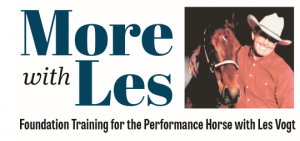 Since in last lesson’s exercises we asked you to be conscious of the horse’s nose getting too far out in a turn, this exercise shouldn’t be new to you. But before, you only used the outside rein to correct problems; here I want you to use the outside rein consciously, as you ask the horse to really break at the poll and bring his nose toward his chest from the lateral flexion position.
Since in last lesson’s exercises we asked you to be conscious of the horse’s nose getting too far out in a turn, this exercise shouldn’t be new to you. But before, you only used the outside rein to correct problems; here I want you to use the outside rein consciously, as you ask the horse to really break at the poll and bring his nose toward his chest from the lateral flexion position.
Begin by walking a circle to the right, with light rein contact and your horse’s frame matching the circumference of the circle, just like you did in the last lesson. Now make contact with your left rein and very gently, with just your fingertips, work your hands back and forth until your horse softens his neck and starts to bring his nose in toward his chest. While you’re moving the reins, you’ll want to gently squeeze with your calves to encourage him to keep moving up over the bit rather than slowing down. As soon as your horse softens to your rein pressure and moves his nose in toward his chest, release your cues and reward him.
Patience, pressure and release lead to behavior change
“Don’t train around problems -- meet them head on and train through them. This eliminates stagnant plateaus in her training program and presents opportunities…”
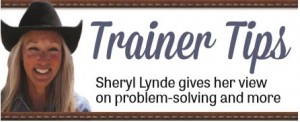 Bella is a 7-year-old Thoroughbred who was abandoned. All that could be established was that she was severely underweight and extremely fearful. She eventually landed at a rescue owned by Carole Harris, Horse Nation, where she has remained for the past couple of years. Early on, getting close, touching or haltering Bella was difficult. Even after they were able to halter her, she would frequently bolt or strike as she reared. Bella’s potential adopter, Diane, needed reassurance that she would be able to safely handle — and someday ride — the mare. Over the past two years, Carole and Diana sought outside help, and there had been improvement in her handling, as Bella eventually could be haltered and lunged. But her behavioral issues endured, and although Carole and Diana recognized potential in Bella, the mare’s reputation as being dangerous prevented progress – like being saddled, bridled, rode or exposed to different areas and terrain. Instead, she was relegated to her stall and round pen.
Bella is a 7-year-old Thoroughbred who was abandoned. All that could be established was that she was severely underweight and extremely fearful. She eventually landed at a rescue owned by Carole Harris, Horse Nation, where she has remained for the past couple of years. Early on, getting close, touching or haltering Bella was difficult. Even after they were able to halter her, she would frequently bolt or strike as she reared. Bella’s potential adopter, Diane, needed reassurance that she would be able to safely handle — and someday ride — the mare. Over the past two years, Carole and Diana sought outside help, and there had been improvement in her handling, as Bella eventually could be haltered and lunged. But her behavioral issues endured, and although Carole and Diana recognized potential in Bella, the mare’s reputation as being dangerous prevented progress – like being saddled, bridled, rode or exposed to different areas and terrain. Instead, she was relegated to her stall and round pen.
More on Vertical Flexion
30th in a series
 Last issue, Les covered the “nuts and bolts” of vertical flexion. Now, let’s take an overview.
Last issue, Les covered the “nuts and bolts” of vertical flexion. Now, let’s take an overview.
It’s important not to ask for too much from your horse at once. You don’t have to get the total result from your horse right from the start, but you do want the thought—the gesture—that he is willing to think about giving his nose to the pressure on the rein. When you first ask, your horse could give you a real negative gesture by lifting his neck when he feels the rein—let’s hope not! But a positive gesture would be him thinking, just thinking, about dropping his nose and rounding his neck when he feels you pick up. Always give him a big “atta boy” for positive gestures.
Vertical flexion: 1 component of collection
29th in a series
 We say a horse is “soft in the bridle” when he has achieved soft vertical flexion – that is, when the horse will drop his nose by rounding his neck and poll whenever he feels light contact with both reins. Your ultimate goal is to get this reaction from your horse before you’ve even taken all the slack out of your reins—like you could ride with silk threads and not break them—wouldn’t that be great! We all dream about it!
We say a horse is “soft in the bridle” when he has achieved soft vertical flexion – that is, when the horse will drop his nose by rounding his neck and poll whenever he feels light contact with both reins. Your ultimate goal is to get this reaction from your horse before you’ve even taken all the slack out of your reins—like you could ride with silk threads and not break them—wouldn’t that be great! We all dream about it!
But I’ll warn you right now, it won’t happen if you’re still feeling any resistance when you ask for lateral flexion. If you are still getting resistance to either side, you need to keep working that before you start into asking for much flexion vertically. If you ask too soon, you’re likely to create a dull mouth in your horse rather than the soft, responsive one that you’re after. Each step builds upon the one before it, and getting each step perfect, before you move on to the next one, is critical.
Vertical flexion: Giving at the poll
28th in a series
Last issue, Les wrapped up lateral flexion with some details on steering. Now he takes us into vertical flexion—an important component of stops, circles…and much more.
Objective
To begin to get your horse to give at the poll as a result of soft pressure on his mouth with both reins
Skills You Will Develop
Timing: Timing is critical in this stage of the program. You want to make sure that you reward your horse instantly when you get the result you want so he learns to give and not pull.
Whether a hot, warm or cold blood, understand traits before you sell short!
HEY RAY!: I know you are very familiar with the Andalusian. I have an awesome Azteca gelding I am considering selling with incredible movement—great for dressage. When he moves, he has a “paddling” motion with his front feet. I believe the correct term is “Termino”. This is part of the Paso Fino movement, but is it acceptable in the Andalusian breed?
-Heidi Mahler
More on turns: Important details
27th in a series
After using pattern exercises the last two issues, Les wraps up his lesson with some key points. Who’s steering anyway? A very simple concept that can be easy to forget is this: If you’re not telling your horse to turn, he should be going straight. Too many riders let the arena fence do their steering for them, and when they come off it they, and the horse, can really get lost. So get off the rail, look up, then pick a point and trot toward it. What happens? Odds are your horse will start drifting toward what interests him, and you get an excellent training opportunity for him and yourself!
How fast can you reward your horse?
24th in a Series
Last issue, Les discussed some methods to deal with pressure and communication. Now let’s look in detail at the process.
The better you get at rewarding your horse for the correct response or even the correct thought, the faster he is going to progress through this program. 
This means that before he can be trained, you need to become trained. You need to get to the point where your hands respond to the presence and absence of resistance in your horse’s mouth, almost before your brain comprehends it. Think for a minute about when you drive a car (or, for our younger readers, ride a bicycle). When you come to a curve in the road, do you mentally stop and think about how you’re going to make it around the corner before you actually start to move the wheel? Probably not if you’ve been driving for more than a few months. Your riding has to start to become the same way:
Is your dream horse really a nightmare to train?
Columnist Ray Ariss has tips.
HEY RAY! I’m an avid dressage rider who has owned many horses, but my Dutch Warmblood is by far the horse of my dreams. He has everything — looks, size, movement and disposition. My only wish is that he would listen to me better.He is totally dull to my aids, and it seems like the more I squeeze the less he goes. Where do I go from here?
—Debra of Arizona


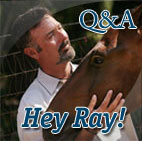
 Read Columns
Read Columns
